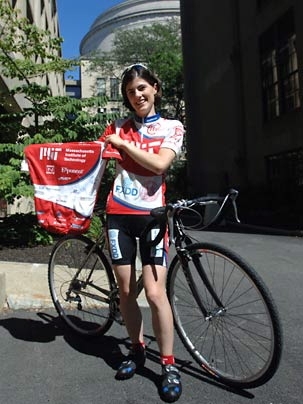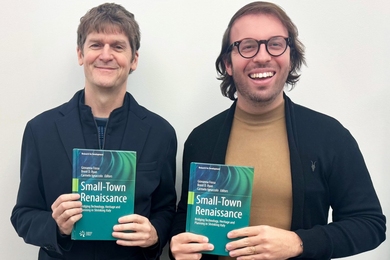MIT cycling team members have found a way to combine the scientific excellence in the halls of MIT with their athletic pursuits.
In order to raise money for the team this year, the cyclists asked four Nobel laureates and one winner of the A.W. Turing Award to dig out their indelible markers and autograph two official cycling team jerseys.��
Each of the jerseys bears the signatures of Institute Professor Jerome Friedman, who won the 1990 Nobel in physics; Wolfgang Ketterle, the John D. MacArthur Professor of Physics, who won the 2001 Nobel in physics; Robert Horvitz, the David H. Koch Professor of Biology, who won the 2002 Nobel in physiology; Institute Professor Phillip Sharp, who won the 1993 Nobel in medicine/physiology; and Ronald Rivest, the Viterbi Professor of Computer Science, who won the Turing Award in 2003.��
The Turing Award, presented by the Association for Computer Machinery, is considered the Nobel Prize of computing.
The jerseys will be auctioned on the online site eBay, and proceeds will go to the team's expenses for the next racing season.
"There are a lot of pretty famous people here at MIT," said Sonya Cates, the women's team captain, who helped hatch the idea at one of the team's fund-raising meetings earlier this year. "We thought, why not try to use that to help our team?"
The team's goal is to raise enough from donors, sponsors and the auctions to send a full men's and woman's team, roughly 8 to 16 members, to the national competition in Kansas. Cates estimated that their expenses will total roughly $9,000.
Additionally, the team needs to raise enough to pay for lodging and transportation to attend other out-of-state competitions. "Entry fees alone can be $800," Cates said. "It all adds up fast."
This year, the team was the Eastern College Conference Cycling Champion. "We plan to do it again next year," Cates said. The team's coach is professional and Olympic cyclist Nicole Freedman.
The MIT Cycling Team is popular with both undergraduate and graduate students, at least partly because it is a club sport, so no experience is required to join and the competitions are tiered according to skill. "Entry-level people can compete," Cates said.
The team is also truly co-ed, Cates said. Although the men and women don't race each other, all 37 cyclists have to work together to succeed in competition. The women's team cannot win without the men's and vice versa. "It is very unusual among college sports," Cates said.
The team members buy their own equipment. Since a good racing bicycle can cost anywhere from $500 to $5,000, "we want to have all of our other costs covered," Cates said. "We are hoping with some famous signatures, the jerseys will raise more money on eBay."
The eBay auction started on Aug. 23 and will end on Aug. 30. For more information, visit www.mitcycling.org.







